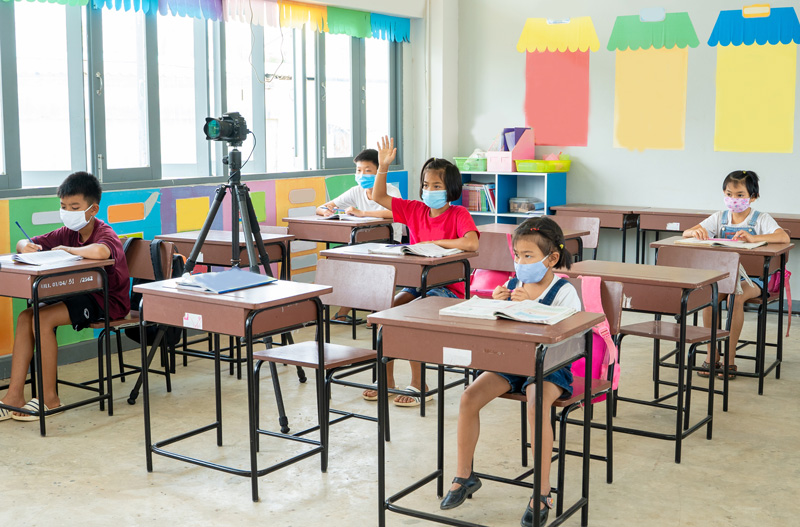To say that schools have changed a lot in the past few months is an understatement. And, as a result, our students need to learn new rules and routines before they can start learning about academics. At the beginning of each school year, you typically teach this information. This year, it is much more important that you teach and practice rules and routines to protect the health of our students, ourselves, and the community. This will take time. You may find that you don’t focus on academics during the first week or two of school as much you have during the past. This is good.
If you spend the first week of school directly teaching, modeling, and practicing routines, challenges in the classroom will dramatically decrease.
– Kathleen Quill

The following supports will help ALL students from preschool through high school. They are evidence-based, increase learning, and reduce anxiety.
Skills to Teach
There are four skills that students must learn to use across the school day: social distancing, wearing a mask, how and when to wash hands, and keeping hands to oneself.
How to Social Distance

Amy Moore Gaffney, MA, CCC-SLP
It is generally accepted that in indoor settings, students should stand six feet away from each other. Students can be taught to distance themselves using boundary markers, hula hoops, or using outstretched hands as an informal measurement.
The following resources provide information on social distancing:
- https://www.cdc.gov/coronavirus/2019-ncov/prevent-getting-sick/social-distancing.html
- https://www.teacherspayteachers.com/Product/What-is-Social-Distancing-A-Story-For-Children-5668223
- https://afirm.fpg.unc.edu/sites/afirm.fpg.unc.edu/files/covid-resources/Support%20Understanding-Giving%20People%20Space%20When%20Talking.pdf
- https://afirm.fpg.unc.edu/sites/afirm.fpg.unc.edu/files/covid-resources/Support%20Understanding-Giving%20People%20Space.pdf
How to Wear a Mask
The mask should completely cover the nose and mouth with the elastic straps tucked behind the ears. It is important to teach students, “I wear a mask to protect you; you wear a mask to protect me.”
Mask protocol and the importance of masks are discussed here:
- https://www.cdc.gov/coronavirus/2019-ncov/prevent-getting-sick/diy-cloth-face-coverings.html
- https://www.healthychildren.org/English/health-issues/conditions/COVID-19/Pages/Cloth-Face-Coverings-for-Children-During-COVID-19.aspx
- https://www.teacherspayteachers.com/Product/Wearing-A-Mask-Story-for-Children-5463572
- https://www.youtube.com/watch?v=iE6L-4tO-rs
- https://www.youtube.com/watch?v=OLO1GNXKmNE
How to Wash Your Hands
Experts suggest that you scrub your hands for at least 20 seconds. It is important to teach students to watch all parts of their hands. For example, the most used part of the hand – the thumb – is also the least washed. The following resources teach handwashing:
- https://www.cdc.gov/handwashing/when-how-handwashing.html
- https://www.iidc.indiana.edu/irca/resources/covid19-visuals-and-social-narratives.html
- https://afirm.fpg.unc.edu/sites/afirm.fpg.unc.edu/files/covid-resources/Support%20Understanding-Handwashing%20%28Clipart%29.pdf
- https://afirm.fpg.unc.edu/sites/afirm.fpg.unc.edu/files/covid-resources/Support%20Understanding-Handwashing%20%28Photos%29.pdf
- https://afirm.fpg.unc.edu/sites/afirm.fpg.unc.edu/files/covid-resources/Support%20Understanding-Handwashing.pdf
Don’t Touch
People should avoid touching their face without first washing their hands. To prevent the spread of germs and COVID-19, avoid touching surfaces that can be touched by a variety of people, such as doorknobs, light switch, keyboards, etc.In addition, students should be encouraged not to touch each other – no high fives or holding hands.
- https://www.cdc.gov/coronavirus/2019-ncov/prevent-getting-sick/prevention.html
- https://www.cdc.gov/coronavirus/2019-ncov/prevent-getting-sick/how-covid-spreads.html
- https://www.youtube.com/watch?v=8uOMXmlsgls
Routines
The following are routines that children need to learn to stay safe and be active learners. Six evidence-based strategies are highlighted that can be used to teach them.
The Six Strategies
- Schedule / To-Do List
- The schedule visually tells what activities will occur and their order. The schedule helps the student move from one task to the next.
- The to-do list visually tells what tasks the student needs to complete and in what order to complete them.
- A student will benefit from a combination of a schedule and to-do lists. For example, the student’s schedule may indicate that the day begins with Morning. The to-do list contains all of the tasks that should be completed during Morning Work time.
- Physical Structure
- Physical structure refers to the way furniture and materials are arranged to help students understand what happens each area.
- Social Narrative
- Social narratives are stories that use words and sometimes pictures to explain a variety of social situations. These can be read over and over. Often written in first person, the social narrative typically tells the reader what to expect to do, what others will do, and how people will react. The social narrative is written positively to encourage the person to do what is expected.
- Video Modeling
- Video modeling is a visual teaching strategy that demonstrates a skill, routine, or behavior to a person. The person will often re-watch the video in order to put the target skill, routine, or behavior into practice.
- Signs/Cards
- Signs or cards visually present information to support comprehension. These visuals are static, allowing for multiple opportunities to reference to support recall.
- Reinforcement
- A preferred item is provided following a desired behavior to increase the likelihood that the behavior will occur again.
Related Resources
The Indiana Resource Center for Autism website offers free edit-and-print Word documents of visual supports and social narratives, along with examples of visual schedules and structure. Browse our visual supports
COVID-19 specific visual supports and social narratives are also available. Browse our COVID-19 visual supports
Get The Toolkit
We’re making this introduction and detailed routines available for free to anyone who needs it as a downloadable PDF. Distribute it to teachers in your school or district, or use it yourself in your own classroom.
Download this Toolkit
Amy Moore Gaffney, MA, CCC-SLP, is an Educational Consultant for Indiana Resource Center for Autism. For more information, visit https://www.iidc.indiana.edu/pages/irca.
This article is reprinted with permission. You may view the original article at https://www.iidc.indiana.edu/irca/resources/articles/transitioning-back-to-school-during-covid.html.




